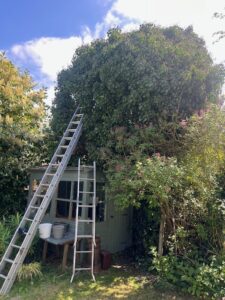This website uses cookies so that we can provide you with the best user experience possible. Cookie information is stored in your browser and performs functions such as recognising you when you return to our website and helping our team to understand which sections of the website you find most interesting and useful.

The second week of April saw us tackling a range of complex and rewarding jobs, from managing ancient cedars in Highgate to restoring order in a wonderfully wild garden on the Crouch End/Highgate borders—sometimes affectionately known as “Crouch End Heights” by the local estate agents!
Highgate: Breathing Room for a Majestic Cedar
Our week began beneath the broad canopy of a TPO-protected Cedar of Lebanon in Highgate. This is a tree with history—both majestic and troubled. Historic storm damage had left the crown unbalanced, and several of the heavier limbs were showing signs of stress. With the potential for breakage very real, we approached this with the utmost care and attention.
With planning consent in place, we carried out:
-
Crown thinning to improve airflow and light penetration,
-
Sensitive limb reduction to ease the strain on weakened laterals, and
-
Deadwood removal to reduce congestion and hazards.
It was a long day’s work, and by the time we were done, 1.5 tonnes of wood had been taken to the recycling depot. The transformation was remarkable—the tree looked as though it could finally breathe again. The cleared canopy revealed the striking natural formation of its branch structure, reminding us just how stunning a healthy, well-managed tree can be.
Crouch End Heights: Orchard Management & an Unexpected Threat
Later in the week, we returned to a large, characterful garden on the Crouch End/Highgate borders—a space we last visited three years ago. The garden is home to a beautiful collection of fruit trees—Apple, Pear, Plum, Elder, and Hawthorn—interspersed with large flowering shrubs and the odd climbing Rose, which made a few tasks rather thornier than expected!
The goal here was to scale back the growth, ensuring each tree had room to thrive without overwhelming its neighbours. We focused on bringing everything back into proportion, preserving the sense of space and airiness that had been slowly lost.
During the visit, the client pointed out a more urgent concern: her neighbour’s dead Weeping Willow, now entirely consumed by Ivy, had collapsed against her summer house. Upon inspection, it became clear the base of the tree was severely decayed and no longer able to support the combined weight of the trunk and dense Ivy growth.
On Friday, we began the delicate task of dismantling the Willow/Ivy structure. Much of the top weight was safely removed, but the remaining work was so precarious, it would have to wait until the following week. With the summer house directly in the firing line, precision and planning are going to be key. Let’s just say… it made for a nerve-wracking weekend.


Wrapping Up
This week brought us everything from conservation-level tree management to thorny tangles and hidden hazards. Whether we’re restoring a centuries-old cedar or navigating ivy-wrapped willows in tight garden corners, our approach remains the same: safety, sensitivity, and a deep respect for the trees and the spaces they shape.
Areas We Cover:
- Crouch End N8
- Archway N19
- Tufnell Park N7
- Highgate N6
- Hampstead NW3
- Camden NW1
- Haringey N8
- Finsbury Park N4
- Islington N1
- Barnet Herts
- Muswell Hill N10
- Kentish Town NW5
- Golders Green NW11
- Cricklewood NW2
- NW10
- Stoke Newington N16
- North London
Tree Types
London Plane, Birch, Sycamore, Lime, Apple, Cedar, Ash. Acer, Amelanchier, Apple, Almond, Buddleia, Beech , Birch, Cedar, Cypress, Conifer, Cherry, Damson, Elder, Forsythia, Lanurnum, Laurel, Leylandii, Leyland, Lilac, Magnolia, Maple, Mountain Ash, Wistaria. Plum, Prunus, Rowan, Oak, Sorbus. Sycamore, Walnut, Mulberry, Willow, Pear, Yew and more!
